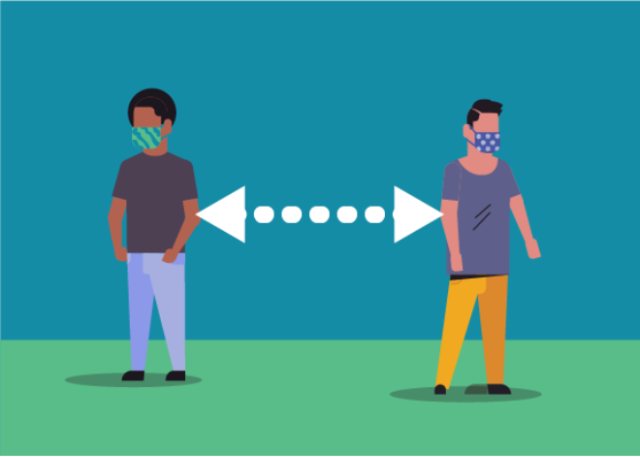Limiting face-to-face contact with others is the best way to reduce the spread of coronavirus disease 2019 (COVID-19).
What is social distancing?
Social distancing also called “physical distancing” is maintaining space between yourself and other people outside of your home. To practice social distancing:
- Stay at least 6 feet (about 2 arms’ length) from other people
- Do not gather in groups
- Avoid crowded places and mass gatherings

In addition to everyday steps to prevent COVID-19, keeping space between you and others is one of the best tools we have to avoid exposure to this virus and, thus, slow its spread locally, nationally, and globally.
When COVID-19 is spreading in your area, everyone should limit close contact with individuals outside their household in indoor and outdoor spaces. Since people can spread the virus before they know they are sick, it is important to stay away from others when possible, even if you don’t display symptoms. Social distancing is especially important for people who are at higher risk of getting very sick.
Why practice social distancing?
COVID-19 spreads mainly among people who are in close contact (within about 6 feet) for a prolonged period of time. Spread happens when an infected person coughs, sneezes, or talks, and droplets from their mouth or nose are launched into the air and land in the mouths or noses of other people. These droplets may be inhaled into the lungs. Recent studies indicate that people who are infected, but do not have symptoms also play a role in the spread of COVID-19.
It is possible a person can contract COVID-19 by touching a surface or object that has the virus on it and then touching their own mouth, nose, or eyes. However, this is not thought to be the main way the virus spreads. COVID-19 can live for hours or days on a surface, depending on factors such as sunlight and humidity. Social distancing helps limit contact with infected people and contaminated surfaces.
Although the risk of severe illness is different for everyone, anyone can get and spread COVID-19. Everyone has a role to play in slowing the spread and protecting themselves, their family, their co-workers, and their community.
Tips for social distancing
- Follow guidance from authorities where you live.
- If you need to shop for food or medicine at the grocery store or pharmacy, stay at least 6 feet away from others.
- Use mail-order for medications, if possible.
- Consider a grocery delivery service.
- Cover your mouth and nose with a cloth face coverings when around others, especially when you have to go out in public.
- Avoid large and small gatherings in private places and public spaces, such as a friend’s house, parks, restaurants, shops, or any other place. This advice applies to people of any age, including teens and younger adults.
- Work from home when possible.
- If possible, avoid using any kind of public transportation, ridesharing, or taxis.
What is the difference between quarantine and isolation?
Quarantine
Quarantine is used to keep someone who might have been exposed to COVID-19 away from others. Someone in self-quarantine stays separated from others and limits movement outside of their home or current residence. A person may have been exposed to the virus without knowing it or could have the virus without feeling symptoms. Quarantine helps limit further spread of COVID-19.
Isolation
Isolation is used to separate sick people from healthy people. People who are in isolation should stay home. In the home, anyone sick should separate themselves from others by staying in a specific “sick” room and using a different bathroom (if possible).
This information is courtesy of the Centers for Disease Control and Prevention (CDC). You may learn more and stay up to date by visiting https://www.cdc.gov/coronavirus/2019-ncov/index.html.



